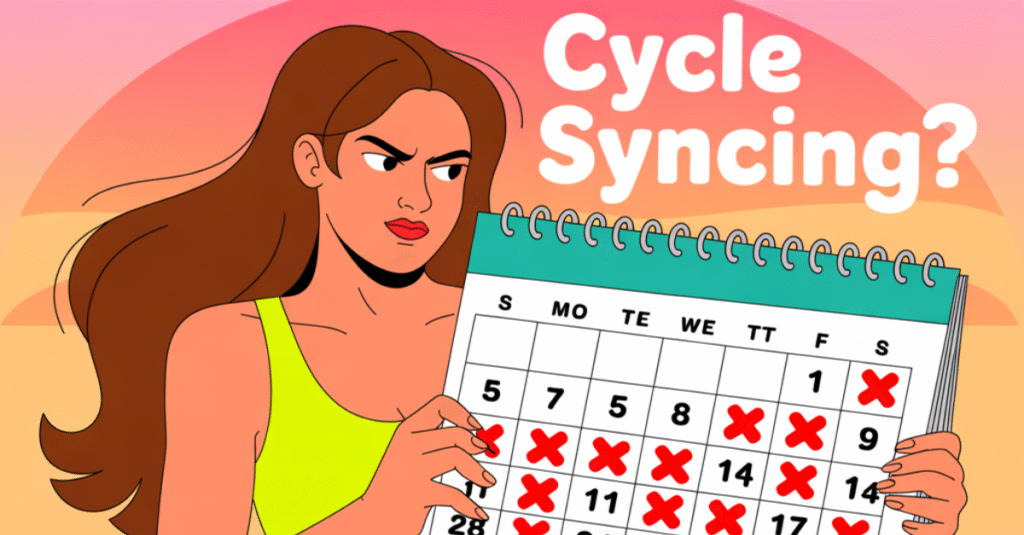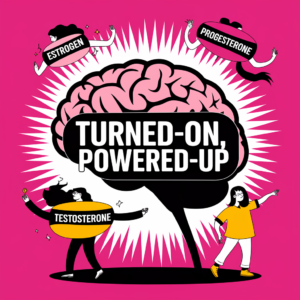You’ve been told to sync your workouts to your cycle. But here’s what no influencer says: The science doesn’t back it up.
Meta-analysis shows only a 1.5% average dip in performance during your period, with wild variation. Translation? As trendy charts suggest, your hormones might shift, but they don’t dictate your strength, endurance, or metabolism.
If you’ve skipped a workout because your app told you to “rest,” you might limit progress for no reason.
Dr. Amy Killen breaks it down: what the data actually supports, when syncing helps (if ever), and what to do instead so you can stop second-guessing your workouts and start trusting your body.
Because syncing to your cycle isn’t the flex, self-awareness is.
What Is Cycle Syncing—and Why Does It Sound So Logical?
Cycle syncing is the concept that women should align their exercise, diet, and even social energy with the four phases of the menstrual cycle:
- Menstruation (Days 1–5): Gentle movement, more rest, focus on iron-rich foods.
- Follicular Phase (Days 6–13): Rising energy—great time for HIIT and new challenges.
- Ovulation (Around Day 14): Peak performance—sprint, lift, be social.
- Luteal Phase (Days 15–28): Energy wanes, so shift to lighter strength training, carbs, and prioritizing sleep.
It sounds empowering—finally, a health framework built around female physiology, not reverse-engineered from studies on men but centered on our hormonal shifts.
And honestly? There’s comfort in structure. Having a system can feel like having control.
But this elegant theory unravels when it’s held up to actual scientific scrutiny.
What the Science Actually Shows
There’s a widespread belief that certain times of the month are better—or worse—for physical performance. And while that idea feels logical, the research doesn’t strongly support it.
A 2020 meta-analysis looked at how exercise performance varies throughout the menstrual cycle. Some women performed better during their period, others worse, and many noticed no change at all.
That’s important because it suggests that the cycle phase alone isn’t a reliable predictor of how you’ll feel, move, or recover.
Additional research backs this up. Studies on trained athletes show that metabolic rate, strength, and endurance remain largely stable across all four phases. And a 2023 expert review was even more direct: “little to no evidence” that syncing your workouts to your hormonal cycle improves outcomes.
In short, consistency matters more than precision timing.
Hormones, Oxygen, and Individual Patterns
Image: Freepik
In 2025, a new case study furthered the conversation. Researchers followed a 21-year-old elite-level female athlete through her full menstrual cycle, tracking everything from muscle oxygen saturation (SmO₂) to strength performance and body composition.
Here’s what they found:
- Minor fluctuations in muscle and fat mass throughout the month
- A significant spike in strength output—from 4–5 reps to 13–14, during ovulation
- Likely links to increased estrogen and potential testosterone elevation mid-cycle
This response may explain why some women feel more powerful in the ovulatory phase. But we should be cautious: this is one athlete, not a universal model.
Still, this study’s unique feature is its inclusion of muscle oxygen tracking, an emerging metric that could offer new insights into how women’s bodies respond to effort during each phase.
So what’s the takeaway? Hormonal shifts may influence performance, but not predictably, and not the same way for every woman.
The best training plan remains individualized, responsive, and built on self-awareness, not rigid phases.
What About Eating for Your Cycle?
Cycle syncing often extends beyond movement into food. Think: more carbs during the luteal phase, fewer fats during the follicular phase, and magnesium before your period. The idea is to balance your plate with your hormones.
But here’s what evidence shows: while certain nutrients like magnesium and calcium may ease PMS symptoms, no reliable data is proving that macro shifts by phase boost performance or hormonal balance.
Yes, many women feel hungrier in the week before their period. You might crave chocolate, salt, or carbs. That’s not weakness—that’s your biology communicating.
So instead of micro-tracking food around a calendar, try this: notice your hunger signals, cravings, and energy shifts. Your body is already telling you what it needs.
When Flexibility Turns Into Restriction
The trouble with cycle syncing isn’t the concept—it’s how easily it turns into a rigid rulebook.
Say your app tells you it’s a “low-energy” phase. So, you skip a run that normally helps with cramps. Or you skip lifting because your calendar said “light yoga only.” Slowly, you start mistrusting your instincts.
That’s when syncing stops helping and starts getting in the way.
We know that consistent movement throughout your cycle, not phase—perfect planning, delivers benefits. Regular exercise during your period can reduce cramps, improve mood, and even help regulate your cycle.
And a lot of the so-called “limits” you hear about working out on your period? They’re cultural myths, not biological ones—just dressed up in pink and branded as empowerment.
Your body isn’t fragile. It’s adaptive. And true strength comes from tuning in, not tuning out.
Why Does Cycle Syncing Feel So Right?
Image: Freepik
Why is cycle syncing so widespread if the evidence doesn’t support it?
Four big reasons:
- It feels intuitive. Structured ideas are easier to follow, even if the science is weak.
- It fills a long-standing gap. Women have been underrepresented in medical research, and we’re hungry for data that speaks to us.
- It’s great for clicks. “Sync your workouts” is an easy sell. “It depends” isn’t algorithm-friendly.
- It feels empowering. Listening to your body feels like taking your power back.
But here’s the uncomfortable truth: empowerment without accuracy is just branding.
Real power comes from understanding your own body—not mimicking someone else’s cycle chart.
Is Better Research on the Horizon?
Yes—and it’s about time.
As of 2025, the first formal multi-center clinical trial is underway to test whether syncing exercise and nutrition to menstrual phases actually impacts symptoms, hormone levels, or performance.
That data will help clarify things. But until we see peer-reviewed results, cycle syncing remains a theory, not a treatment.
And like many wellness trends, it has simply outpaced the science.
What Should You Actually Do?
Here’s what works—without the overcomplication:
Track your energy—not your app.
Some months, day 2 wipes you out. Other times, you’re fine. Your body’s signals are more reliable than a generic calendar. Pay attention to them.
Treat symptoms as information, not instructions.
Fatigue, cravings, mood swings—they’re real, but they’re not fixed. One rough cycle doesn’t predict the next. Adjust in real time.
Aim for consistency, not choreography.
You don’t need to follow a perfectly timed plan. You need habits that hold—regardless of what week it is.
Every phase is movement-friendly.
There’s no phase where exercise becomes unsafe or off-limits. Research hasn’t found one. If it feels good, it is good.
The Bottom Line
Cycle syncing offers a neat solution to a complex, ever-shifting system. But your body isn’t a four-phase spreadsheet. It’s a dynamic rhythm—part biology, psychology, and life.
If syncing helps you feel more in tune and keeps you consistent, keep doing it. But if it adds hesitation, doubt, or guilt? You’re better off opting out.
The strongest plan isn’t syncing. It’s self-awareness.
Forget perfect timing. Trust your pattern. Because the best cycle to follow is your own. Share your experience below. Your story might be just what another woman needs to hear.













